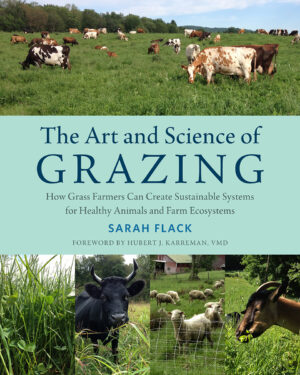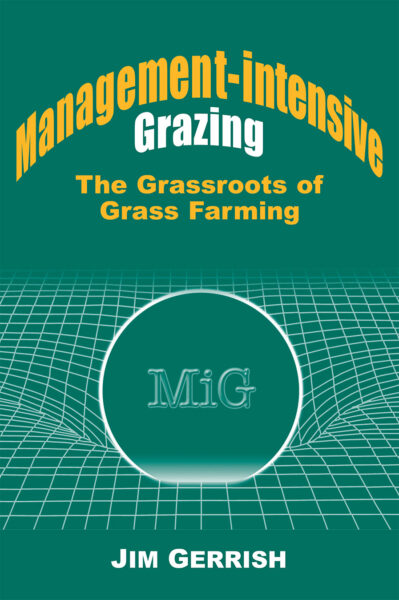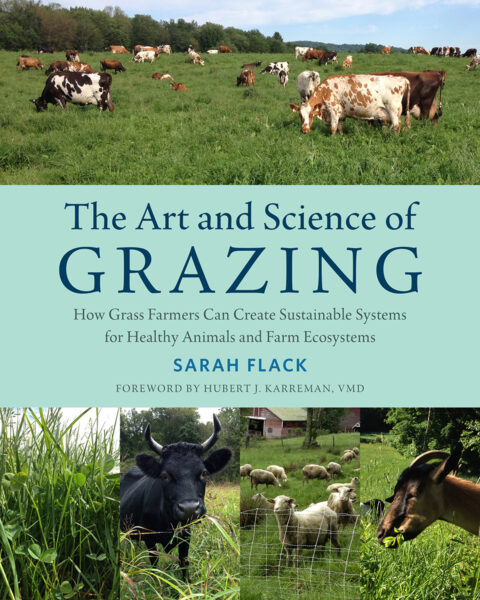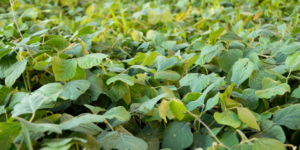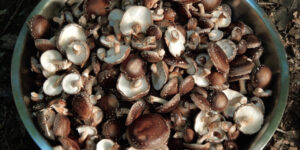Good Grazing Makes for Healthy Pastures, People, and Planet
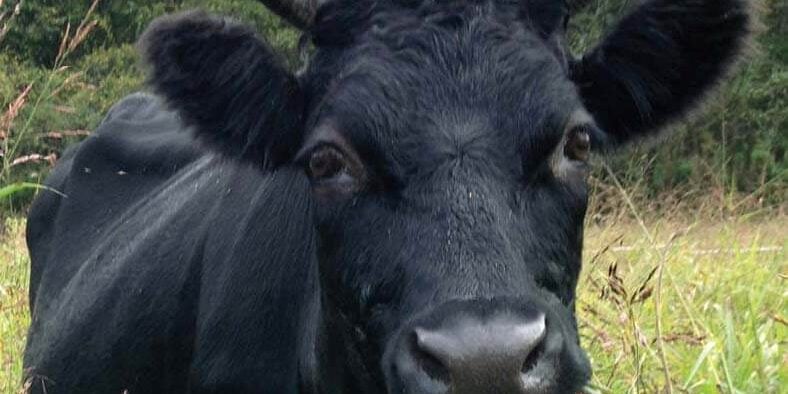
In her new book, The Art of Science and Grazing, nationally known grazing consultant Sarah Flack identifies the key principles and practices necessary for farmers to design, and manage, successful grazing systems.
This book is an essential guide for ruminant farmers who want to crate grazing systems that meet the needs of their livestock, pasture plants, soils, and the larger ecosystem – especially as it pertains to making agriculture a solution in the fight against climate change. Below is an excerpt from her book, which outlines the benefits of good pasture management.
Have you noticed that some pastures seem to run out during the grazing season so that cows have to be fed more in the barn? Have you ever wondered why some pastures become weedy, stay short, or are full of plants the animals won’t eat? Many of these problems are caused by poorly designed grazing systems, or they result from damage to pasture plants and soils caused by poor management.
When done well, grazing management can improve animal well-being, ecological health, and the financial sustainability of the farm. An effectively designed and managed grass-based livestock operation requires that the farmer understand the basic principles of grazing management and ecology. It also requires an understanding of what pasture plants and livestock need, and how to put that information together with the right infrastructure. This knowledge makes it possible for the farmer to choose which type of grazing system best fits the farm and family goals, and customize it so that the system is practical and works well.
The pasture ecosystem includes many interrelated parts including plants, soils, animals, local weather, and the farmer. (Yes, humans are part of the ecosystem!) Many factors affect the types of plants in a pasture and how vigorously they grow. Such factors can include how animals are being used to harvest the plants and how well manure is being distributed, as well as the impact of hooves, the weather, and the past and current management of soil fertility and health. Grazing systems that are designed and managed with an understanding of these factors create many benefits. However, poorly designed and managed pastures can lead to many problems, including negative impacts on the ecosystem.
For beginner farmers or those new to grass-based livestock farming, the number of suggestions on the “best way” to improve soil fertility, forage quality, and pasture production can be overwhelming. This is particularly challenging for farmers who have not yet learned the fundamental principles of good grazing management. Without a solid understanding of the basic guidelines of how to set up and manage a pasture system, itís easy to get sidetracked by the latest fads and spend money on unnecessary or impractical infrastructure and inputs. This can result in a system that doesnít meet your quality-of-life goals or the financial needs of the farm, and it can jeopardize the productivity and welfare of the livestock.
To be a good grass farmer, you need technical and scientific knowledge of grazing management and animal husbandry, plus the observation and monitoring skills to see subtle changes over time in livestock, soils, and pasture plants. With this knowledge, farmers have found diverse creative ways to apply good grazing principles to many types of land bases with different types of livestock.
How Grazing Improves Pasture
When done correctly, livestock grazing can create many benefits for the environment, plants, soils, animals, and farm income. Good grazing management can cause the mix of plant species in a pasture to change even without tillage and reseeding, simply as a result of animal impact. When animals spend time in a pasture, they do more than just eat. They trample weeds and dead plants into the soil, which adds organic matter and can improve soil biological activity. They choose certain plants to eat, and they spread their own manure. In just a few years, this combination of activities can convert weedy brushy pastures, where animals have to search to find good quality forage, into highly productive pastures capable of supporting more animals and providing a higher quality of forage. As pastures improve, plant density and diversity increase, which protects soils from erosion and compaction. In addition to the visible above ground improvement, there is also increased plant root growth and better cycling of nutrients through the soil so they are more available to plants and other soil life.
Well-managed pasture provides low-cost, high-quality feed. This is particularly helpful for farmers who must deal with rising costs of purchased feed, combined with the expense of harvest and storage of forages. With good pasture management, most sheep and beef farms should be able to completely eliminate feeding grain or stored forages during the grazing season. For some dairy farms, it may be possible to significantly reduce or, in some cases, completely eliminate grain feeding. However, at the time of this writing it is probably still more profitable for most dairy farms to supplement pasture with grain, due to the current cost of grain and pay price for milk. (See chapter 11 for more detail on 100 percent grass feeding.)
In addition to lower costs due to reduced supplemental feed purchases, there are also fewer labor and input costs because the livestock harvest their own feed, which reduces or eliminates the need for mechanical harvest, storage, and feeding. There will still be some expense when starting a grazing system, because fencing and some investment in seed and soil fertility may be needed. Still, the benefits of a well-managed system will generally cover the costs!
When pastures are designed and managed well, there will be a better seasonal availability of high-quality pasture. This can allow grazing to start earlier and run later into the fall or winter. This lowers the expense of purchased fuel, labor, and equipment repairs. For example, a small beef herd with just 20 head can consume 8 to 10 round bales a week. At $40 per bale, the farmer can save as much as $400 for each week the grazing season is extended into the fall. This savings can be reinvested in more fence, seed, or fertility inputs. Or it can go into the vacation savings account!
Benefits of Good Grazing ManagementImproved financial sustainability is an important benefit of well-designed and -managed pastures. But lower costs and higher yields are just two of the many positive impacts from grass-based agriculture. There will also be improved living conditions and animal well-being, along with a whole array of ecological benefits. |
Benefits to Animals
|
Benefits to Farmers
|
Benefits to the Planet and Humans
|
Benefits to Livestock and Humans
Good grazing management can improve livestock health due to better nutrition, lower stress, and greater opportunity for natural herd or flock behavior. This can reduce cull rates, produce longer-lived animals, lower vet bills, and make it possible to earn additional income from sales of livestock. Cattle on pasture also spread their own manure and mow the weeds.
When their diet is mostly or entirely from pasture, animals produce meat and milk with different amounts and types of nutrients than what grain-fed livestock produce. The nutrients that appear in higher amounts in grassfed meat and milk include carotenoids, vitamin E, omega-3 fatty acids, conjugated linoleic acid (CLA), and other nutrients.
Research on the human benefits of increasing dietary CLA intake indicates that doing so may lower the risk of cancer and heart disease. Research also shows that increasing omega-3 fatty acids in relation to omega-6 fatty acids may reduce the risk of cancer, obesity, diabetes, and other illnesses.1 Grassfed products are also higher in healthy antioxidants, including vitamin E and carotenoids such as lutein, zeaxanthin, and beta-carotene.
This information can be used to provide some new marketing opportunities. It is not surprising that the higher nutritional value of these foods attracts health-minded consumers, and many consumers also appreciate the other benefits of grass farming, including improved animal welfare and environmental health. Many of the ecological benefits of well-managed pasture-based production systems are a result of having higher-density populations of deep-rooted perennial plants and healthy, biologically active soils. Benefits from the perennial soil cover include decreased soil erosion and improved water quality due to improved soil stability and less nutrient runoff. In addition, with the livestock doing the harvesting and manure spreading, there is less fossil fuel used and fewer emissions of greenhouse gases, and carbon is actually sequestered in plants and soil. These perennial pastures are highly diverse, which also improves wildlife habitat.
Recent Articles
Want to see your crops thrive this upcoming growing season? The key is in soil fertility and health. Spend time maintaining your soil’s health to guarantee bigger and better crops come harvest time! The following is an excerpt from No-Till Intensive Vegetable Culture by Bryan O’Hara. It has been adapted for the web. What Is Soil Fertility?…
Read MoreMany know the effects of catnip on our feline friends, but few realize that catnip has medicinal effects for humans. From stomach aches to reducing fevers, catnip is a versatile herb with many benefits. The next time you grow this plant for your cat you may end up taking a few cuttings for yourself! The…
Read MoreIt’s time to take control of your seeds and become a plant breeder! Saving your seed allows you to grow and best traditional & regional varieties, and develop more of your own. The following excerpt is from Breed Your Own Vegetable Varieties by Carol Deppe. It has been adapted for the web. Becoming A Plant…
Read MoreTrying to figure out how to manage weeds in your garden beds? Use cover crops and living mulches for weed suppression while your garden flourishes! The following is an excerpt from The Ecological Farm by Helen Atthowe. It has been adapted for the web. Suppressing Weeds With Cover Crops: Getting Started Cover crops suppress weeds…
Read MoreInterested in becoming a mushroom farmer? Shiitake mushrooms are one of the easiest and most profitable places to start. The following is an excerpt from Farming the Woods by Steve Gabriel and Ken Mudge. It has been adapted for the web. (Photographs courtesy of Steve Gabriel and Ken Mudge unless otherwise noted.) The Stunning Shiitake…
Read More

